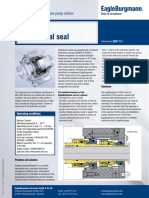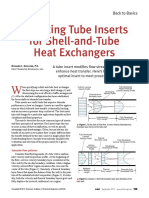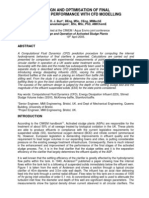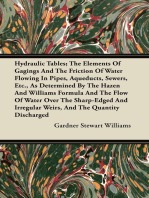Dec06feature PDF
Dec06feature PDF
Uploaded by
Amgad_SCopyright:
Available Formats
Dec06feature PDF
Dec06feature PDF
Uploaded by
Amgad_SOriginal Title
Copyright
Available Formats
Share this document
Did you find this document useful?
Is this content inappropriate?
Copyright:
Available Formats
Dec06feature PDF
Dec06feature PDF
Uploaded by
Amgad_SCopyright:
Available Formats
N
ew crystallization-system de-
signs rely on previous success-
ful installations and rules for
scaling-up systems to adapt to
slightly different conditions. However,
guidelines or rules of thumb have
underlying assumptions that might
have been ignored when scaling-up a
system during the design phase. This
practice often leads to difficulties in
practical application. This point will
be clearly illustrated by the following
real-life example.
Draft-tube-baffle crystallizers
Draft-tube-baffle (DTB) crystalliz-
ers are used to produce coarse mate-
rial with a long wash-out cycle. The
draft tube conveys the solids to the
boiling surface, where supersatura-
tion is the highest, and the baffle
provides a positive means to control
both slurry density and population
balance. Hundreds of DTB crystal-
lizers have been installed over the
past 40 years. Most of them have
performed as designed and serve as
references for future designs.
Geometrically similar crystallizers
have the same pressure drop, which
is expressed as a multiple of the draft
tube velocity head. Knowledge of this
rule certainly makes it easier for the
agitator manufacturer to match equip-
ment to the desired operating condi-
tions. But determining how well this
match is achieved is difficult because
the measurement of slurry flow in a
draft tube is deemed impossible. Veri-
fying the performance
with clear liquid is the
next most-accurate ap-
proach, in principle, but is time-con-
suming, costly and, therefore, seldom
done. Instead, a geometrically similar
model is usually built and tested in
water with scale-up rules applied for
the commercial unit.
Seldom is the reality confronted
when problems arise, and mishaps
in operation are used as excuses: the
level went too low or the particle size
grew beyond the expected design, re-
sulting in the loss of suspension. As a
result, the agitator performances are
left unverified.
Troubleshooting a real plant
Soon after the startup of the worlds
largest potash crystallizer train (Fig-
ure 1), it was obvious that the agita-
tors could not maintain the crystals
in suspension. The low-solids concen-
tration (about 6 wt.%), the size of the
particles at which the suspension was
lost (the average particle size in the
first stage was 1.0 mm) and good level
control (documented with trend lines
from the DCS) eliminated the usual
explanations for such an occurrence.
An indicator for loss of suspension
is demonstrated by the pattern shown
in Figure 2. This cyclical pattern con-
sists of a simultaneous jump of the
agitator current (amperage; upper
curve) and density (lower curve). In
this time frame, the level fluctuations
can be traced to the density variations
inside the crystallizer. The jump is fol-
lowed by a drop in amperage when
the crystallizer has discharged the
solids accumulated at the bottom of
the crystallizer and the slurry density
returned to a level equal to or slightly
below that at the time of the jump.
Observation of the boiling surface
shows a rough boiling when the am-
perage is high sometimes charac-
terized by geysers erupting from the
draft tube and a normal boiling
when the amperage is low.
Analyzing samples taken from the
crystallizer only caused confusion; the
samples showed a much higher den-
sity than indicated by the instrument
in the control room when the amps
were high and agreed with the control
room values when the amps were low.
The explanation for this observation
is that, while the instrument mea-
sures an average density, the samples
taken are not representative of the lot.
When the suspension is uniform, the
sample taken from the bottom of the
crystallizer agrees with the instru-
ment panel. When suspension is lost,
the solids accumulate in the bottom of
the crystallizer and are discharged at
a much higher rate until the circula-
tion is reestablished.
Meanwhile, an increase in the agita-
tor speed resulted in only a slight im-
provement. It was quickly established
that both the system designer and the
Feature Report
38 ChemiCal engineering www.Che.Com DeCember 2006
Feature Report
FIGURE 1. Draft-tube-baffle crystallizers are used to
produce coarse material with long washout cycle. Shown
here is the worlds largest potash crystallizer train
Crystallizers
And Agitators
Jean-Claude Gallot
HPD, a Veolia Water Solutions & Technologies Co.
Amnon Schur
Dead Sea Works
Past performance is not
a guarantee of success
38-41 CE 12-06.indd 38 11/22/06 4:26:19 PM
agitator manufacturer had followed
common practices and only minor de-
viations could be found. This became
an extremely critical issue and had to
be resolved.
Theory
An agitator in a draft tube can be as-
similated to a low-head, axial-flow
pump. The characteristic curve of
the impeller must match the system
curve represented by the crystallizer
internals. Calculation of the system
pressure drop usually yields such low
head values that a coefficient must be
introduced to line up calculated results
and measurements. This coefficient is
usually attributed to the pinch point
and draft tube entrance. The low heads
are difficult to measure even in a labo-
ratory environment. Accurate mea-
surements on a geometrically similar
model are made in clear liquid, the
K value for the draft tube (number of
velocity heads) is determined and the
performance of the agitator is known
for a geometrically similar crystallizer.
Using this method, the slurry circulat-
ing in the crystallizer is assumed to
behave the same as a liquid because
the design velocities of the largest par-
ticles are about one order of magnitude
larger than the free settling velocity.
Pumping numbers and power
numbers are used by agitator manu-
facturers rather than the head-flow
characteristics that are published for
axial-flow pumps. Generally speaking,
the former were developed to prevent
motor burn out and for an impeller
used in a standard baffled tank with-
out a draft tube. Unlike that of axial-
flow pumps, the performance of an
agitator is seldom verified in the com-
mercial plant.
In our case, a battery of tests were
conducted to verify the performance of
the agitator using clear liquor.
Findings
Although the crystallizer was
equipped with pressure taps to mea-
sure the differential head of the agita-
tor, no characteristic head-flow curve
was available to verify the flow. Power
measurement could only be made in
the master-control-center (MCC) room
due to safety concerns, adding to the
level of uncertainty. The flow was then
measured in conjunction with the
head measurement using Ottmeters
spread across the top of the draft tube.
(Ottmeters measure the flow velocity
in one direction.)
The flow was calculated by integrat-
ing the velocities along the diameter of
the draft tube. The flow was varied by
modifying the level inside the crystal-
lizer and by changing the speed of the
agitator. Knowing the flow, the veloc-
ity head was calculated and compared
to the measured pressure drop estab-
lishing the K value of the draft tube.
This testing revealed two things:
1. The level had a marked influence on
the flow
2. The design flow was not achieved
The first observation was expected since
level was one parameter used to vary
the flow. The second observation indi-
cates that the impeller was clearly not
operating according to the manufactur-
ers curve. This was attributed to the
minor deviations in construction from
standard practices. These included a
slightly reduced area (86%) for the draft
tube supports that act as vortex break-
ers, and a larger-than-recommended re-
duction in draft tube cross-section area
due to the upper supports.
A computational-fluid-dynamics
(CFD) study made it possible to predict
the improvement caused by removing
the obstruction at the discharge of the
impeller, which represented a 15%
contribution to the total system head.
Figure 3 shows the effect of level
above the top of the draft tube and il-
lustrates the strong vortex created
at relatively low coverage. Given this
data, the decision was made to make
the following modifications: enlarge the
draft-tube supports in the lower part of
the crystallizer; replace the tubes sup-
ports inside the draft tube with flat
plates, which will act as an anti-vortex-
ing mechanism; and cut the top part of
the draft tube to increase the coverage
ChemiCal engineering www.Che.Com DeCember 2006 39
100
Ad-hoc trend
CrystaIIizer #1
90
80
70
60
50
40
30
20
10
0
18 20 24 00
6/28
02 04 06 08 10 12 14 16
P64D4791
0.4
%
P64A440_E
62.6
% Amps
27-Jun-04 16:57:31 24.00 hour(s) 28-Jun-04 16:57:31
FIGURE 3. CFD calculations can be useful to predict improvements caused by
changes in a crystallizer. Here one observes the effect of increasing the liquid level
over the draft tube from low coverage (left) to high (right)
FIGURE 2. This cyclic pattern, observed when plotting the agitator motor current
(top) and density (bottom) versus time, is an indication for loss of suspension
38-41 CE 12-06.indd 39 11/22/06 4:27:12 PM
while maintaining the operating level.
These modifications would allow the
system to exceed design flow in clear li-
quor at a slightly higher than designed
agitator speed.
After making these modifications,
a second set of measurements yielded
the following results:
The agitator characteristic was now
matching the one predicted by the
manufacturer
The expected flow in liquid was
achieved
The importance of the coverage was
drastically reduced
Figure 4 shows a plot of the draft tube
K value (number of velocity head) as a
function of the coverage (distance be-
tween the liquid surface and the top of
the draft tube). Before modifications
of the crystallizer were made, the K
value was observed to rise sharply at
low coverage (upper curve). After the
modifications, the curve was almost
flat (lower curve). The K values them-
selves are quite different, dropping for
a coverage of one draft tube dia. to half
the initial value; for a normal cover-
age of 0.5 draft-tube dia. to a third of
the previous value; and for a 0.2 draft-
tube dia. coverage to only 22%.
Additional laboratory testing
This dramatic change did solve the
loss of suspension problem, but the
maximum slurry density that could
be kept in suspension was somewhat
short of the original requirement.
A model that was geometrically
similar to the commercial plant was
set up at the test facility of the agita-
tor manufacturer to establish the re-
lationship between agitator speed and
flow delivered at various slurry densi-
ties while observing any failure modes.
The controlled conditions in the model
eliminated level and particle size vari-
ations while allowing measurement of
power and flow via an impeller with
known characteristics. An ultrasonic
probe, which measures the velocity
along one axis, was used to monitor
the flow inside the draft tube. The agi-
tator speed could be varied continu-
ously from 0 to 700 rpm while speed,
torque and power were monitored.
The first run in water established
that the relation between agitator
speed and flow was linear. Using a 5
wt.% solids slurry of 93-m-dia. glass
beads and starting from high speed
(700 rpm), solids deposited at the bot-
tom of the vessel where the local veloc-
ity is low. As the speed was decreased,
the deposit increased as the local ve-
locity decreased. This filleting was
reversed when the agitator speed was
increased. No loss of suspension was
observed at 300 rpm.
When a 10 wt.% solid slurry was
used, the flow was basically the same
as that of the lighter slurry at the same
high speed. As the speed was lowered,
the flow in the draft tube became un-
stable as evidenced by the velocity
fluctuations shown by the probe. A
clear interface appeared at the surface
of the vessel at 500 rpm. The velocity
had dropped to nearly half that of the
starting velocity and the torque had
also decreased. Further reduction of
the agitator speed resulted in a point
where the velocity in the draft tube
started to fall rapidly with an increase
in torque. Suspension was lost and the
system subsequently crashed.
The same phenomenon was observed
at 15 and 20 wt.%. Each time, the agi-
tator speed was higher at the point
where suspension was lost. These ob-
servations are plotted in Figure 5.
The solids deposition at the bottom
of the crystallizer is like the filleting
found in the corner of a flat bottom
tank. It was not significant enough
to choke the draft tube entrance. This
was also true at 5% solids when no
loss of suspension was observed and
could not be the reason for the loss of
suspension.
There was a reduction in flow when
solids were added. An additional back
pressure was required to reduce the
flow. It is highly unlikely that a short
pipe, such as a draft tube, would in-
crease the pressure gradient due to
solids, thereby causing the pressure
drop to increase fourfold.
Plotting the ratio of velocity in
water to the incipient crash velocity
as a function of the slurry concentra-
tion, results in a curve that seems to
indicate that above 20 wt.% solids, the
flow reduction tapers. The hindered
settling-velocity effect takes over. This
indicates that the slurry flow is half
that of clear liquid above 20% sus-
Draft tube K vaIue Effect of coverage
-
1.00
2.00
3.00
4.00
5.00
6.00
7.00
8.00
9.00
10.00
- 0.200 0.400
Coverage h/D
0.600 0.800 1.000 1.200
DSW test
Aug. 20,
2004
DSW test
Feature Report
40 ChemiCal engineering www.Che.Com DeCember 2006
0.6
0.5
0.4
0.3
D
T
v
e
l
o
c
i
t
y
0.2
0.1
0
0 100 200 300 400
rpm
Dec. 2, 2004
500 600 700 800
Slurry suspension in draft tube
D/2 coverage
Water run
5% solids added
15% added
20%
10% solid
Note: velocity probe was
moved between water
run and slurry runs
FIGURE 4. This plot of the draft-tube K value versus cover-
age shows the effect of making physical modifications to the
crystallizer (see text)
FIGURE 5. Laboratory observations of various slurry con-
centrations versus agitator speed
38-41 CE 12-06.indd 40 11/22/06 4:27:57 PM
pended solids, as shown in Figure 6.
Plotting the absorbed power as a
function of the density and agitator
speed results in a curve that deviates
markedly from the cube of the agitator
speed as one would expect. Instead,
the exponent value was slightly less
than 1.3. The cause for the deviation
from the normal third-power depen-
dence on the speed is due to vortexing
or insufficient baffling.
Results and discussion
A difference in solids concentration
between the inside and the outside of
the draft tube would create such ad-
ditional differential pressure. Assum-
ing that this concentration difference
is due to the slip velocity between the
solid and the carrier, a derivation was
made that would account for all the
parameters.
The system pressure drop is formed
of two terms:
One term depends on the hydraulic
of the system and can be expressed
as a multiple of the draft tube veloc-
ity head. It is about 25% of the head
in slurry
A second term depends on the con-
tribution from the slurry
The slurry contribution is proportional
to the following parameters:
The draft tube height
The difference in density between
solids and liquid
The solids concentration
A term which includes a geometric
factor and the ratio of the design
slurry velocity to the
slurry velocity
The slurry contribu-
tion is, meanwhile,
and is inversely pro-
portional to:
The slurry density
Replacing the slurry
velocity by its expres-
sion as a function of
solid concentration
and the terminal ve-
locity, we see a maxi-
mum of around 20%
by volume suspended
solids.
The geometrical fac-
tor, which accounted
for the ratio of draft-
tube area to outside of
the draft tube, accounts for about 10%
of the slurry head.
This derivation explains the short-
comings of the rules of thumb used
in scaling-up equipment. Assimilating
a slurry to a liquid cannot predict the
improvement observed by speeding
the agitator. It is true that a system
pressure drop follows a quadratic
curve as does the agitator head. The
K value of the draft tube ignores the
height of the draft tube, which in large
units, differs sensibly from more com-
mon sized equipment. The geometric
similitude is valid only for the head
due to the liquor, which is only a frac-
tion of the head in slurry.
The flow reduction, due to level
variations, is small if proper baffling
is used. The relative position of this
baffling to the impeller plays an im-
portant role. It might explain why the
flow is different for up or down pump-
ing. The guidelines used in the past
for baffling are therefore insufficient.
Only with proper baffling will the
power be proportional to the cube of
the agitator speed.
Because the flow is dependent on
the solids concentration, the super-
saturation varies accordingly, adding
an extra feed back parameter to the
crystallization.
Pumping numbers have little mean-
ing for systems other than standard
baffled tanks. There is a flow, hence a
pumping number, for each head. Pub-
lished characteristic head/flow curves
for each family of impeller would be the
first step in comparing the variety of
impellers on the market and verifying
the claims made by manufacturers.
Conclusions
Verification of liquor flow delivered
by an agitator in a draft tube does
not ascertain that the performance
in slurry will be met
Above 35 wt.%, suspended solids
add a pressure drop that varies with
the solids concentration
The pressure is proportional to the
height of the draft tube, therefore
geometrical similarity does not pre-
dict the head required
When proper baffling is used, the
sensitivity to level fluctuation is
greatly diminished
Rules of thumb used up until this
point should be replaced with accu-
rate and verifiable methods; power
measurements alone do not verify the
performance (flow) of the agitator
Pumping numbers are meaningless
in this application. They should be
replaced with characteristic curves
for each family of impeller as is done
for pumps. Consider this: No one
specifies a pump based on its pub-
lished specific speed.
Edited by Gerald Ondrey
ChemiCal engineering www.Che.Com DeCember 2006 41
FIow reduction due to soIids
SIurry concentration, %bw
2.20
2.00
1.80
1.60
1.40
1.20
1.00
0 5 10 15 20 25 30
Authors
Jean-Claude Gallot is a se-
nior process engineer at HPD,
a Veolia Water Solutions &
Technologies company (23563
West Main St., IL Route 126
Plainfield, Ill. Phone: 815-
609-2037; Fax: 815-609-2044;
Email: Jean-claude.gallot@
veoliawater.com). Gallot has
over 34 years of process-de-
sign experience in evapora-
tion and crystallization tech-
nology. He holds two patents in the field, and has
applied for two additional patents. Gallot earned
a B.S. in chemical engineering from Escom
(Paris, France).
Amnon Schur is the process
engineering manager for the
Hot Leach Crystallization
Plant of Dead Sea Works, Is-
rael (P.O. box 75, Beer Sheva
84100, Israel. Phone: +972-
57-773-7265; Fax: +972-8-997-
7475; E-mail: amnons@DSW.
co.il). Amnon obtained B.Sc.
in chemical engineering from
Ben-Gurion University, and is
completing his M.Sc. from the
Technion institute, Israel. His current research
interests include modeling of crystal size distri-
bution and dynamics of leaching processes. He
is responsible for the engineering aspects of the
production and for leading the R&D programs in
the plant. Amnon was the leader of the commis-
sioning team in the new Dead Sea Works crystal-
lization plant, and won various competitions as
the leader of improvement teams.
FIGURE 6. Plotting the ratio of the flow velocity in water
to the incipient crash velocity as a function of slurry con-
centration provides an indication of the flow reduction
due to solids
38-41 CE 12-06.indd 41 11/22/06 4:29:04 PM
You might also like
- Plant Engineers Guide To Agitation Design and FundamentalsDocument33 pagesPlant Engineers Guide To Agitation Design and FundamentalsMark MacIntyre100% (1)
- Technical Presentation ThermosyphonDocument25 pagesTechnical Presentation ThermosyphonBrenda ElianaNo ratings yet
- Raven 3800 MixerDocument3 pagesRaven 3800 Mixersantosh kumar100% (1)
- 814 1991Document32 pages814 1991Balasubramanian Singaravelu100% (1)
- Thermascrew: Advanced FeaturesDocument3 pagesThermascrew: Advanced FeaturesFLIRIDIR1678No ratings yet
- Confronting Crystallization IssuesDocument8 pagesConfronting Crystallization IssuesBramJanssen76No ratings yet
- Plate Heat Exchanger Working PrincipleDocument11 pagesPlate Heat Exchanger Working PrinciplemanoNo ratings yet
- P 475188Document33 pagesP 475188Parth PatelNo ratings yet
- 872 en PDFDocument12 pages872 en PDFNavaneetha KumaranNo ratings yet
- Xu Distillation How To Push A Tower To Its Maximum Capacity PDFDocument9 pagesXu Distillation How To Push A Tower To Its Maximum Capacity PDFRajendraNo ratings yet
- Barometric Condencer PDFDocument5 pagesBarometric Condencer PDFPhilip ShihNo ratings yet
- Uso de Baffles en TanquesDocument6 pagesUso de Baffles en Tanquesdavid0205No ratings yet
- Scaba Kevero enDocument12 pagesScaba Kevero enSuphi YükselNo ratings yet
- Boiler CirculationDocument76 pagesBoiler CirculationDavitxu1No ratings yet
- Steam Mains Trap Design GuideDocument37 pagesSteam Mains Trap Design GuideTrina Ritchell AquinoNo ratings yet
- GrothDocument91 pagesGrothnicolasgonzNo ratings yet
- Process Pump ControlDocument4 pagesProcess Pump ControlBramJanssen76No ratings yet
- SteamTraps PDFDocument123 pagesSteamTraps PDFUsMan ZaFarNo ratings yet
- The Unexpected Rewards of Testing A MixerDocument4 pagesThe Unexpected Rewards of Testing A MixerJoshua JohnsonNo ratings yet
- Guide To Design and Selection of Check ValvesDocument18 pagesGuide To Design and Selection of Check ValvessimitzuNo ratings yet
- Section 06B - PumpsDocument62 pagesSection 06B - PumpsRajesh Kumar100% (1)
- Chem September 2013Document84 pagesChem September 2013Orlando BarriosNo ratings yet
- Condensate Recovery in Industrial Steam SystemsDocument20 pagesCondensate Recovery in Industrial Steam Systemsammar fahmiNo ratings yet
- Flooded CondensersDocument13 pagesFlooded Condensersstreamt100% (1)
- 100 Year Search Ideal Mass Transfer DeviceDocument17 pages100 Year Search Ideal Mass Transfer DevicesaverrNo ratings yet
- Conveying FeedersDocument8 pagesConveying FeedersMarcelo Antonucci Cos100% (1)
- Ips-E-Pr-771 SthexDocument43 pagesIps-E-Pr-771 Sthexdr_s_m_afzali8662No ratings yet
- Franklin Dura-Seal Valve BrochureDocument10 pagesFranklin Dura-Seal Valve BrochurecarlosNo ratings yet
- 4xx 30 excelThermoPMDocument3 pages4xx 30 excelThermoPMzhyhhNo ratings yet
- EagleBurgmann - E07111 - E1 - Mechanical Seal H75VN in Cumene Pump Station - 11.10Document1 pageEagleBurgmann - E07111 - E1 - Mechanical Seal H75VN in Cumene Pump Station - 11.10lendiaNo ratings yet
- ASHRAE Symposium AC-02-9-4 Cooling Tower Model-Hydeman PDFDocument10 pagesASHRAE Symposium AC-02-9-4 Cooling Tower Model-Hydeman PDFEPEportilloNo ratings yet
- Agitation of Non-Newtonian FluidsDocument8 pagesAgitation of Non-Newtonian FluidsandresjypNo ratings yet
- Fired Heaters - Improving Energy Efficiency in FurnacesDocument2 pagesFired Heaters - Improving Energy Efficiency in FurnacesReyes Sanchez100% (1)
- An Attrition Test With A Sieve Shaker For Evaluating Granule StrengthDocument6 pagesAn Attrition Test With A Sieve Shaker For Evaluating Granule Strengthm1974aminNo ratings yet
- End Face Mechanical Seal: Navigation SearchDocument16 pagesEnd Face Mechanical Seal: Navigation SearchCarlito PantalunanNo ratings yet
- Figure 1. Ejector System For Soybean Oil DeodorizerDocument11 pagesFigure 1. Ejector System For Soybean Oil DeodorizerjarofidzNo ratings yet
- Heat Exchangers Selecting Tube Inserts For Shell and Tube (Cep) PDFDocument7 pagesHeat Exchangers Selecting Tube Inserts For Shell and Tube (Cep) PDFRicardo Bec100% (1)
- Oil Mist SystemsDocument2 pagesOil Mist SystemsDefenceDogNo ratings yet
- Customized Tower Design PTQ Q2 2013Document8 pagesCustomized Tower Design PTQ Q2 2013Muhammad Noor FadhliNo ratings yet
- FCCU Optimization - A Minimum Capital ApproachDocument6 pagesFCCU Optimization - A Minimum Capital Approachsaleh4060No ratings yet
- PA Process: Thermal EngineeringDocument8 pagesPA Process: Thermal Engineeringlulis171No ratings yet
- Installing Liquid-Ring Vacuum PumpsDocument5 pagesInstalling Liquid-Ring Vacuum PumpsSteve WanNo ratings yet
- Chapter 16Document15 pagesChapter 16Aeromoon AeroseekNo ratings yet
- Vessels For High Pressure Dust CollectorsDocument4 pagesVessels For High Pressure Dust CollectorsWade ColemanNo ratings yet
- CHE 503 Agitation LiquidsDocument33 pagesCHE 503 Agitation LiquidsNurtasha Atikah100% (1)
- Advanced Bioprocess EngineeringDocument110 pagesAdvanced Bioprocess Engineeringdhan_azuelo100% (1)
- Process Distillation Tower DiagnosticsDocument8 pagesProcess Distillation Tower Diagnostics徐孝民No ratings yet
- Whitepaper - BaseplatesDocument10 pagesWhitepaper - Baseplatesrhusseinpos4765No ratings yet
- Mathcad - 2 - 5 - Conveying - 3nDocument4 pagesMathcad - 2 - 5 - Conveying - 3nsujith kumarNo ratings yet
- Replacing A Corroded Column With Packing InternalsDocument4 pagesReplacing A Corroded Column With Packing InternalsPlutarco Chuquihuanga CórdovaNo ratings yet
- Selection of Heatexchanger TypesDocument65 pagesSelection of Heatexchanger TypesRaghav SharmaNo ratings yet
- Kramer H.J.M. - 2000 - Modeling of Industrial Crystallizers For Control and Design Purposes PDFDocument7 pagesKramer H.J.M. - 2000 - Modeling of Industrial Crystallizers For Control and Design Purposes PDFhusseinNo ratings yet
- KSB Pumps - Sewage & Waste WaterDocument3 pagesKSB Pumps - Sewage & Waste Waterashokjj26100% (1)
- SPE168279 - Optimizing Frac Plug Mill Outs in Horizontal Wells Using Coiled Tubing - TTSDocument10 pagesSPE168279 - Optimizing Frac Plug Mill Outs in Horizontal Wells Using Coiled Tubing - TTSfkong16688No ratings yet
- Spe 194597 MS PDFDocument17 pagesSpe 194597 MS PDFMANISH GUPTANo ratings yet
- Clarifier - 1Document13 pagesClarifier - 1wasin2543No ratings yet
- Glass 110421Document5 pagesGlass 110421Julian MartineliNo ratings yet
- Simulation Helps Design More Efficient Control ValveDocument4 pagesSimulation Helps Design More Efficient Control ValveGaurav SinglaNo ratings yet
- Mini DSTDocument0 pagesMini DSTNagaraju JallaNo ratings yet
- Otc 24837 MSDocument8 pagesOtc 24837 MSlishushijieyouyituiNo ratings yet
- Hydraulic Tables; The Elements Of Gagings And The Friction Of Water Flowing In Pipes, Aqueducts, Sewers, Etc., As Determined By The Hazen And Williams Formula And The Flow Of Water Over The Sharp-Edged And Irregular Weirs, And The Quantity DischargedFrom EverandHydraulic Tables; The Elements Of Gagings And The Friction Of Water Flowing In Pipes, Aqueducts, Sewers, Etc., As Determined By The Hazen And Williams Formula And The Flow Of Water Over The Sharp-Edged And Irregular Weirs, And The Quantity DischargedNo ratings yet
- Polymer Report-Very ImpDocument260 pagesPolymer Report-Very Impsanketjjoshi100% (1)
- F3 Factory Final Report To ECDocument50 pagesF3 Factory Final Report To ECAmgad_SNo ratings yet
- Uso de Baffles en TanquesDocument6 pagesUso de Baffles en Tanquesdavid0205No ratings yet
- Metallurgium: Making A Better Mousetrap: The Role of Innovation in Mineral Processing & Metallurgical Plant DesignDocument32 pagesMetallurgium: Making A Better Mousetrap: The Role of Innovation in Mineral Processing & Metallurgical Plant DesignAmgad_SNo ratings yet
- Making The Leap From R&D To ManufacturingDocument3 pagesMaking The Leap From R&D To ManufacturingAmgad_SNo ratings yet
- New Challenges For Biopharmaceutical Process DevelopmentDocument4 pagesNew Challenges For Biopharmaceutical Process DevelopmentAmgad_SNo ratings yet
- The Do's and Don'ts of Scale UpDocument2 pagesThe Do's and Don'ts of Scale UpAmgad_SNo ratings yet
- Conceptual Design For Chemical ProcessesDocument50 pagesConceptual Design For Chemical ProcessesAudrey Patrick KallaNo ratings yet
- From Elements of Chemical Engineering, 2 Edition Badger & Mccabe Mcgraw-Hill, New York, 1936Document3 pagesFrom Elements of Chemical Engineering, 2 Edition Badger & Mccabe Mcgraw-Hill, New York, 1936Amgad_SNo ratings yet
- New Challenges For Biopharmaceutical Process DevelopmentDocument4 pagesNew Challenges For Biopharmaceutical Process DevelopmentAmgad_SNo ratings yet
- Advances in Distillation System Design: Amgad Salah MoussaDocument30 pagesAdvances in Distillation System Design: Amgad Salah MoussaAmgad_SNo ratings yet
- Form Meeting Preparation ChecklistDocument7 pagesForm Meeting Preparation ChecklistAmgad_SNo ratings yet
- Merowe DamDocument38 pagesMerowe DamAmgad_S100% (1)
- F 550 Turbo Diesel 2000-2001Document78 pagesF 550 Turbo Diesel 2000-2001Fernando Ortiz100% (1)
- Periodic Inspection NotesDocument16 pagesPeriodic Inspection NotesShirishNo ratings yet
- Ch6 - Drilling FluidsDocument54 pagesCh6 - Drilling Fluidsretrii27No ratings yet
- Large - Scale Mda From PiperonalDocument1 pageLarge - Scale Mda From Piperonaljiskate77No ratings yet
- Resicrete 2118 - TDSDocument2 pagesResicrete 2118 - TDSPhạm Thanh PhươngNo ratings yet
- Intermolecular Forces, Liquids, and SolidsDocument49 pagesIntermolecular Forces, Liquids, and SolidsfuatNo ratings yet
- LG Multi V - VRF Catalogue 2016Document119 pagesLG Multi V - VRF Catalogue 2016Hung Tran50% (2)
- Experiment 12Document7 pagesExperiment 12JoNo ratings yet
- Norma ISA-7-0-01-1996Document34 pagesNorma ISA-7-0-01-1996Ingrith Julieth Jerez SierraNo ratings yet
- Presentation On Forged Mill Balls Production in South AfricaDocument23 pagesPresentation On Forged Mill Balls Production in South AfricaRamoutar (Ken) SeecharranNo ratings yet
- Compact SPT CartDocument14 pagesCompact SPT CartmytizplickyNo ratings yet
- Plaster Mixing Procedures Application en IG503 PDFDocument4 pagesPlaster Mixing Procedures Application en IG503 PDFRowil GodoyNo ratings yet
- Structured Questions AnswersDocument23 pagesStructured Questions AnswersNg Swee Loong StevenNo ratings yet
- 02 Klingenburg Rotor KataloguDocument34 pages02 Klingenburg Rotor KataloguMohamed AdelNo ratings yet
- Delatte 2001 Lessons From Roman Cement and ConcreteDocument7 pagesDelatte 2001 Lessons From Roman Cement and ConcreteChandan BhatNo ratings yet
- Do Sim at FeederDocument6 pagesDo Sim at Feederarcelitas100% (1)
- Changing McMurdo E3 EPIRB BatteryDocument12 pagesChanging McMurdo E3 EPIRB BatteryMurdiono channelNo ratings yet
- Lamella Gravity SettlerDocument2 pagesLamella Gravity SettlerIwan Kenichiwa100% (2)
- WF73-320 Eng PDFDocument2 pagesWF73-320 Eng PDFskidamdnevnoNo ratings yet
- 37 Sustainable Construction and Building MaterialsDocument9 pages37 Sustainable Construction and Building Materials薇神No ratings yet
- Manpower DistributionDocument9 pagesManpower DistributionRyanNo ratings yet
- The Influence of Mass Transfer On The Mechanism of Electropolishing of Nickel in Aqueous Sulphuric AcidDocument23 pagesThe Influence of Mass Transfer On The Mechanism of Electropolishing of Nickel in Aqueous Sulphuric Acidqnk7No ratings yet
- SEIN SAC CatalogugDocument75 pagesSEIN SAC CatalogugRahmanu AribowoNo ratings yet
- Parallel Synthesis of 2-Acetamido ThiomorpholinesDocument13 pagesParallel Synthesis of 2-Acetamido Thiomorpholinessantosh_nandanNo ratings yet
- Lebw4978 15Document22 pagesLebw4978 15Victor Nunez100% (1)
- ERIEZ Detectores Metalarm (MD-180F)Document8 pagesERIEZ Detectores Metalarm (MD-180F)angelsiddharta100% (1)
- Ductility Detailing of StructuresDocument8 pagesDuctility Detailing of StructuresRabindraSubediNo ratings yet
- EC - Quick ReferenceDocument3 pagesEC - Quick ReferencevanamgouthamNo ratings yet
- Steel PipeDocument39 pagesSteel PipeJay PanalanginNo ratings yet




































































































